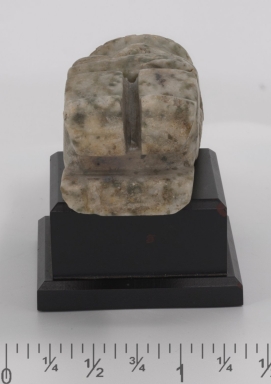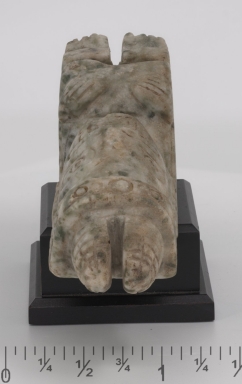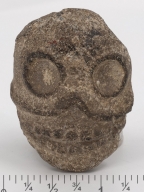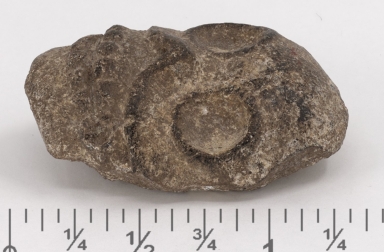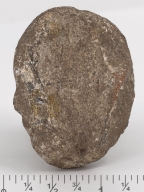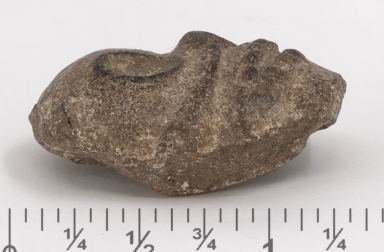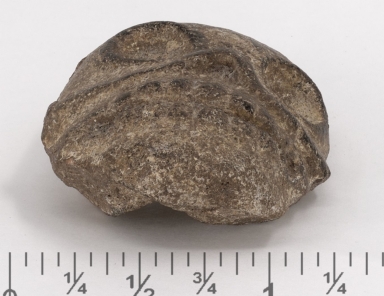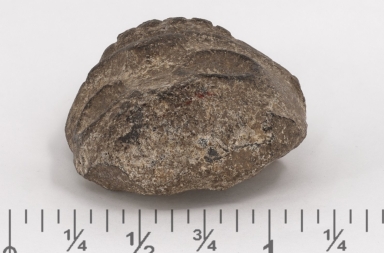Who What Where WhenWHATShow More |
REFINE
Browse All : Artifact and Sculpture--Mexico--Oaxaca (State)
1-12 of 12
Title
Penate : seated stylized human figure wearing a mask and a maize headdress.
Description
The Mixtec sculpture represents a man squatting on the ground with his arms folded on top of his knees. These sculptures called penates are usually small personal amulets. The form of the body remains rectangular and divided into three square areas. They were mass produced for personal use. This large penate is unusual, because he wears a mask and a corn headdress. The Aztec name for this God is Centeotl, the young male corn God.
Subject
[Stone carving--Mexico--Oaxaca (State), Sculpture--Mexico--Oaxaca (State), Mixtec art--Mexico--Oaxaca (State), Indigenous peoples--Antiquities]
Date
between 1260 and 1521
Title
Penate : seated stylized human figure wearing a mask and a maize headdress.
Description
The Mixtec sculpture represents a man squatting on the ground with his arms folded on top of his knees. These sculptures called penates are usually small personal amulets. The form of the body remains rectangular and divided into three square areas. They were mass produced for personal use. This large penate is unusual, because he wears a mask and a corn headdress. The Aztec name for this God is Centeotl, the young male corn God.
Subject
[Stone carving--Mexico--Oaxaca (State), Sculpture--Mexico--Oaxaca (State), Mixtec art--Mexico--Oaxaca (State), Indigenous peoples--Antiquities]
Date
between 1260 and 1521
Title
Penate : seated stylized human figure wearing a mask and a maize headdress.
Description
The Mixtec sculpture represents a man squatting on the ground with his arms folded on top of his knees. These sculptures called penates are usually small personal amulets. The form of the body remains rectangular and divided into three square areas. They were mass produced for personal use. This large penate is unusual, because he wears a mask and a corn headdress. The Aztec name for this God is Centeotl, the young male corn God.
Subject
[Stone carving--Mexico--Oaxaca (State), Sculpture--Mexico--Oaxaca (State), Mixtec art--Mexico--Oaxaca (State), Indigenous peoples--Antiquities]
Date
between 1260 and 1521
Title
Penate : seated stylized human figure wearing a mask and a maize headdress.
Description
The Mixtec sculpture represents a man squatting on the ground with his arms folded on top of his knees. These sculptures called penates are usually small personal amulets. The form of the body remains rectangular and divided into three square areas. They were mass produced for personal use. This large penate is unusual, because he wears a mask and a corn headdress. The Aztec name for this God is Centeotl, the young male corn God.
Subject
[Stone carving--Mexico--Oaxaca (State), Sculpture--Mexico--Oaxaca (State), Mixtec art--Mexico--Oaxaca (State), Indigenous peoples--Antiquities]
Date
between 1260 and 1521
Title
Penate : seated stylized human figure wearing a mask and a maize headdress.
Description
The Mixtec sculpture represents a man squatting on the ground with his arms folded on top of his knees. These sculptures called penates are usually small personal amulets. The form of the body remains rectangular and divided into three square areas. They were mass produced for personal use. This large penate is unusual, because he wears a mask and a corn headdress. The Aztec name for this God is Centeotl, the young male corn God.
Subject
[Stone carving--Mexico--Oaxaca (State), Sculpture--Mexico--Oaxaca (State), Mixtec art--Mexico--Oaxaca (State), Indigenous peoples--Antiquities]
Date
between 1260 and 1521
Title
Penate : seated stylized human figure wearing a mask and a maize headdress.
Description
The Mixtec sculpture represents a man squatting on the ground with his arms folded on top of his knees. These sculptures called penates are usually small personal amulets. The form of the body remains rectangular and divided into three square areas. They were mass produced for personal use. This large penate is unusual, because he wears a mask and a corn headdress. The Aztec name for this God is Centeotl, the young male corn God.
Subject
[Stone carving--Mexico--Oaxaca (State), Sculpture--Mexico--Oaxaca (State), Mixtec art--Mexico--Oaxaca (State), Indigenous peoples--Antiquities]
Date
between 1260 and 1521
Title
Stone fragment : Mictlantecuhtli : Lord of death.
Description
The Nahuatl word "tecuhtli" means "Lord" and "mictlan" means "the underworld." Therefore, Mictlantecuhtli means Lord of the Underworld or Death. He rules the realm of the dead with his wife, Mictlancihuatl.
Subject
[Stone carving--Mexico--Oaxaca (State), Sculpture--Mexico--Oaxaca (State), Mixtec art--Mexico--Oaxaca (State), Indigenous peoples--Antiquities]
Date
between 900 and 1532
Title
Stone fragment : Mictlantecuhtli : Lord of death.
Description
The Nahuatl word "tecuhtli" means "Lord" and "mictlan" means "the underworld." Therefore, Mictlantecuhtli means Lord of the Underworld or Death. He rules the realm of the dead with his wife, Mictlancihuatl.
Subject
[Stone carving--Mexico--Oaxaca (State), Sculpture--Mexico--Oaxaca (State), Mixtec art--Mexico--Oaxaca (State), Indigenous peoples--Antiquities]
Date
between 900 and 1532
Title
Stone fragment : Mictlantecuhtli : Lord of death.
Description
The Nahuatl word "tecuhtli" means "Lord" and "mictlan" means "the underworld." Therefore, Mictlantecuhtli means Lord of the Underworld or Death. He rules the realm of the dead with his wife, Mictlancihuatl.
Subject
[Stone carving--Mexico--Oaxaca (State), Sculpture--Mexico--Oaxaca (State), Mixtec art--Mexico--Oaxaca (State), Indigenous peoples--Antiquities]
Date
between 900 and 1532
Title
Stone fragment : Mictlantecuhtli : Lord of death.
Description
The Nahuatl word "tecuhtli" means "Lord" and "mictlan" means "the underworld." Therefore, Mictlantecuhtli means Lord of the Underworld or Death. He rules the realm of the dead with his wife, Mictlancihuatl.
Subject
[Stone carving--Mexico--Oaxaca (State), Sculpture--Mexico--Oaxaca (State), Mixtec art--Mexico--Oaxaca (State), Indigenous peoples--Antiquities]
Date
between 900 and 1532
Title
Stone fragment : Mictlantecuhtli : Lord of death.
Description
The Nahuatl word "tecuhtli" means "Lord" and "mictlan" means "the underworld." Therefore, Mictlantecuhtli means Lord of the Underworld or Death. He rules the realm of the dead with his wife, Mictlancihuatl.
Subject
[Stone carving--Mexico--Oaxaca (State), Sculpture--Mexico--Oaxaca (State), Mixtec art--Mexico--Oaxaca (State), Indigenous peoples--Antiquities]
Date
between 900 and 1532
Title
Stone fragment : Mictlantecuhtli : Lord of death.
Description
The Nahuatl word "tecuhtli" means "Lord" and "mictlan" means "the underworld." Therefore, Mictlantecuhtli means Lord of the Underworld or Death. He rules the realm of the dead with his wife, Mictlancihuatl.
Subject
[Stone carving--Mexico--Oaxaca (State), Sculpture--Mexico--Oaxaca (State), Mixtec art--Mexico--Oaxaca (State), Indigenous peoples--Antiquities]
Date
between 900 and 1532
1-12 of 12
|




